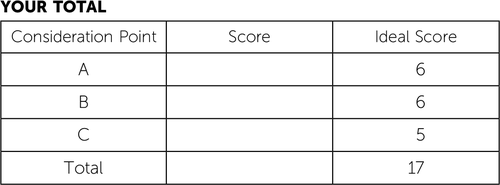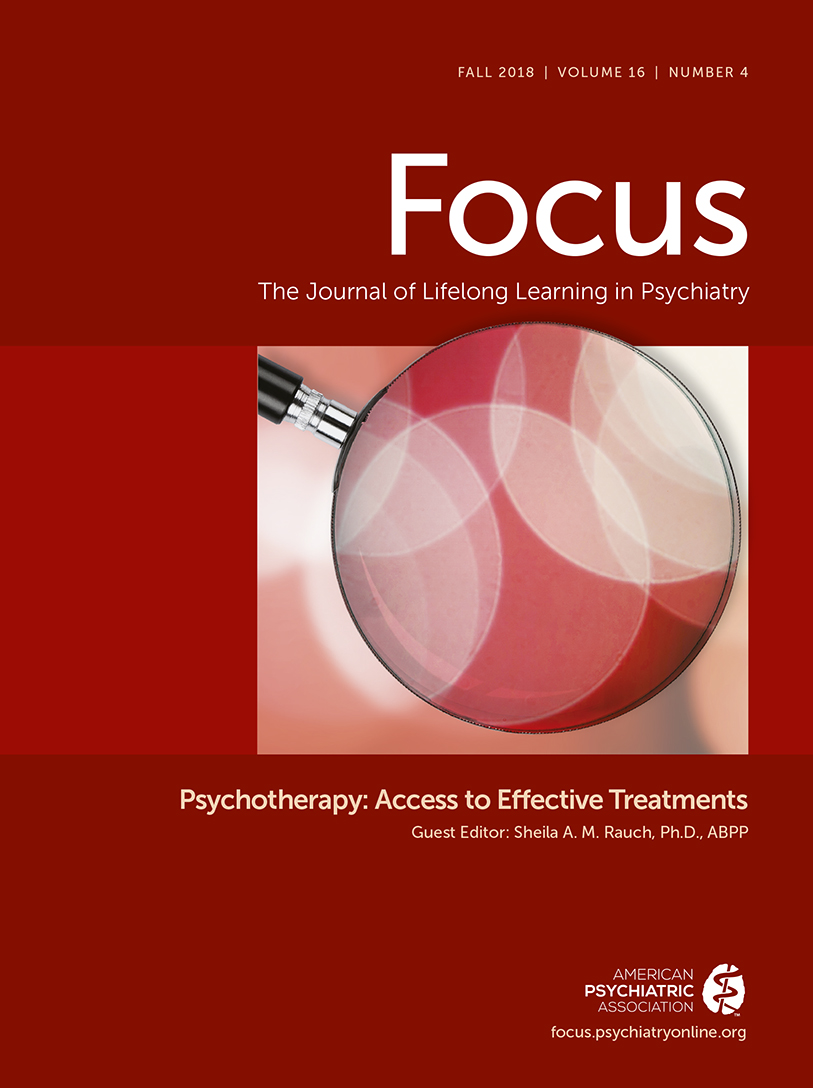Psychotherapy: Use in Persistent Anxiety and Depression
This exercise is designed to test your comprehension of material relevant to this issue of Focus as well as your ability to evaluate, diagnose, and manage clinical problems. Answer the questions below to the best of your ability with the information provided, making your decisions as if the individual were one of your patients.
Questions are presented at “consideration points” that follow a section that gives information about the case. One or more choices may be correct for each question; make your choices on the basis of your clinical knowledge and the history provided. Read all of the options for each question before making any selections. You are given points on a graded scale for the best possible answers, and points are deducted for answers that would result in a poor outcome or delay your arrival at the right answer. Answers that have little or no impact receive zero points. At the end of the exercise, you will add up your points to obtain a total score.
Case Vignette
Samantha Stevens is a 21-year-old woman who was referred to you by her primary care physician (PCP) at her college because she had not responded adequately to trials of two selective serotonin-reuptake inhibitor medications. The referral documents you received described briefly that Samantha had first sought care for anxiety and depression approximately one year ago. Her PCP had initially started a trial of paroxetine, and the patient discontinued it after eight weeks because of a combination of minimal efficacy and unacceptable weight gain. The next trial was of escitalopram; the patient was able to tolerate the medication acceptably but only had “about 25% improvement” in her mood and anxiety levels. She is still taking escitalopram at 20 mg each day.
Consideration Point A
Based on what you know of the patient’s history at this point, which of the following diagnoses would merit consideration?
| A.1. | Unipolar major depressive disorder | ||||
| A.2. | Bipolar disorder type I | ||||
| A.3. | Generalized anxiety disorder | ||||
| A.4. | Posttraumatic stress disorder | ||||
Case Vignette Continues
When the patient came to your office for interviewing, she expanded on her history. She reported that she had been “a nervous kid” growing up and had experienced extreme anxiety in circumstances that her peers had not found unduly stressful, such as going on an overnight school field trip in the sixth grade, going off to college (even though it was a community college in her hometown with several friends in her class), or working part time in a coffee shop on campus. She endorsed that she has had significant symptoms for three years but only sought care a year ago.
Samantha reported that she felt that she was “missing out” on much of the social experiences in high school and college and that this led to her feeling “so very, very disappointed” in herself. She endorsed low self-esteem (“I’m such a loser”) and guilty ruminations about how much it has cost her family for her to go to college and how unable and “unworthy” she felt because she was “not getting the most out of my college experience.” She also endorsed anhedonia: She used to love playing the piano but now had not touched the instrument for more than 18 months. She reported that she felt “keyed up” much of the time and that it often took her more than an hour to fall asleep, only to awaken around 5 a.m., unable to go back to sleep. She reported that she had lost enough weight in the past six months that she had to buy some new clothing in a smaller size.
She acknowledged having “three or four” close friends, two from high school and two whom she had met in college, but said that she often made up excuses not to go out to social events with them. She reported she had not been in a serious romantic relationship in the past five years, noting, “Who would date a basket case like me?” She denied ever having suicidal thoughts, saying, “I still have hope I can feel better: My aunt had depression that drugs didn’t help, but transcranial magnetic stimulation got her well.” Despite her symptoms and functional challenges, she had been able to maintain a B-plus average in her course work with a full course load.
On examination, the patient was pleasant and cooperative, casually attired in loose-fitting clothes, with unkempt hair under a baseball cap. You noted moderate psychomotor agitation, with an excess of spontaneous movement. Eye contact was adequate, and she was occasionally tearful. Speech was of hypophonic volume but normal rate and prosody.
The patient’s affect was anxious, sad, and apprehensive. She characterized her mood by saying, “I’m a nervous wreck, a sad loser.” Her thought process was of normal rate and organization, but she frequently returned to themes of being nervous and insecure. Her thought content was free of hallucinations and current suicidal or homicidal intent; she denied any intention or plan of suicide or other self-injurious behaviors.
Cognitively, she was awake; alert; and oriented to person, place, date, and circumstances. Memory registration was intact with three out of three stimuli, and recall after delay was correct for three out of three items. She was able to spell world forward and backward accurately but slowly. She had no difficulty repeating the phrase “No ifs, ands, or buts.”
Her insight was intact, in that she recognized that her depression and anxiety were making her feel valueless despite her academic performance and that she needed effective treatment. Her judgment was intact, in that she was seeking care and was able to weigh risks and benefits of additional treatments. You noted no tremors or involuntary movements. Her gait was unremarkable.
Consideration Point B
Given all of these details, your recommendations to the patient and her referring PCP are as follows:
| B.1. | Adding adjunctive triiodothyronine | ||||
| B.2. | Referring her to cognitive-behavioral therapy (CBT) | ||||
| B.3. | Adding quetiapine | ||||
| B.4. | Switching to ziprasidone | ||||
Case Vignette Continues
You communicated your impressions to the patient, and she agreed that a trial of CBT was appealing: no new medication-related side effects, and potentially enduring benefits after conclusion of a course of treatment. The patient followed up with a CBT therapist and embarked on an eight-week program of weekly sessions. About two weeks after completing as many sessions as her insurance would cover, she saw you again in consultation because, as she put it, “My self-esteem and mood are much better, but it’s still a very busy place in my head most of the day, and that seems to fuel my anxiousness.”
Consideration Point C
Given her partial improvement with changes you had recommended, what other evidence-based interventions might you consider?
| C.1. | Mindfulness-based cognitive therapy (MBCT) | ||||
| C.2. | Alprazolam for use on an as-needed basis | ||||
| C.3. | Referral to peer support groups for the family and the patient | ||||
Case Vignette Concludes
The patient followed through on your recommendation for MBCT. She found the mindfulness practices to be very helpful: “It really helps me calm myself down, quiet my brain, and stay present in the moment.” She reported that she was better able to relax in the evening, that she usually fell asleep within 10 minutes of going to bed, and that her friends had told her that she was “more cheery . . . your delightfully snarky sense of humor is back.”
Answers: Scoring, Relative Weights, and Comments
Consideration Point A
| A.1. | (+3) Unipolar major depressive disorder. The patient endorsed several of the DSM-5 criteria for major depressive disorder (1). | ||||
| A.2. | (−1) Bipolar disorder type I. The patient has no history of hypomanic or manic episodes to suggest bipolar disorder, but at age 21 she might not have had one yet and is still at risk (1). | ||||
| A.3. | (+3) Generalized anxiety disorder. The patient has given you a history of symptoms consistent with generalized anxiety disorder (1). | ||||
| A.4. | (0) Posttraumatic stress disorder. She has not given you a history of the cardinal symptoms of posttraumatic stress disorder or of a traumatic event that preceded onset of symptoms (1). | ||||
Consideration Point B
| B.1. | (+2) Adding adjunctive triiodothyronine. The augmentation treatment using thyroid hormone preparations was an evidence-based intervention even before it was evaluated in the STAR*D trial (2). Although it may help with primary depressive disorders, its use in anxiety remains underevaluated (3). | ||||
| B.2. | (+3) Referral to CBT. CBT is an evidence-based treatment for both major depression and generalized anxiety disorder (4–7). | ||||
| B.3. | (+1) Adding quetiapine. Second-generation antipsychotic medications, such as quetiapine, may have use as augmentation agents in major depression, and quetiapine may also be helpful with anxiety (8). However, you should give consideration to the patient’s earlier issues with weight gain as an intolerable side effect. | ||||
| B.4. | (−2) Electroconvulsive therapy. Although electroconvulsive therapy is an evidence-based practice for the treatment of depression (9), it is not the usual next step in the treatment algorithm for a patient such as Samantha, who has other well-tolerated interventions available. | ||||
Consideration Point C
| C.1. | (+3) MBCT. Studies have suggested that MBCT may be a useful component of a treatment plan for depression and anxiety disorders (10). | ||||
| C.2. | (+1) Alprazolam. A short-acting GABA-ergic medication may have some use in the acute management of anxiety and depression, but it is often not preferred in the long-term management, and this patient has been symptomatic for years (11). | ||||
| C.3. | (+1) Referral to support groups for the family and the patient. Although formal evidence is still being developed, preliminary data indicate that peer support groups may be helpful to the patient (11). | ||||
 |
Your Total
1 Diagnostic and Statistical Manual of Mental Disorders, 5th ed. Arlington, VA,
2 : A comparison of lithium and T(3) augmentation following two failed medication treatments for depression: a STAR*D report. Am J Psychiatry 2006; 163:1519–1530, quiz 1665Crossref, Google Scholar
3 : Thyroid hormones in panic disorder, panic disorder with agoraphobia, and generalized anxiety disorder. J Clin Psychiatry 1988; 49:229–231Google Scholar
4 : Cognitive-behavioral therapy for anxiety disorders: an update on the empirical evidence. Dialogues Clin Neurosci 2015; 17:337–346Google Scholar
5 : The effects of cognitive behavior therapy for adult depression on dysfunctional thinking: A meta-analysis. Clin Psychol Rev 2015; 42:62–71. doi: 10.1016/j.cpr.2015.08.003Crossref, Google Scholar
6 : The effects of cognitive-behavior therapy for depression on repetitive negative thinking: a meta-analysis. Behav Res Ther 2018; 106:71–85. doi: 10.1016/j.brat.2018.04.002Crossref, Google Scholar
7 : Treatment-resistant depression: definitions, review of the evidence, and algorithmic approach. J Affect Disord 2014; 156:1–7. Available at doi: 10.1016/j.jad.2013.10.043Crossref, Google Scholar
8 : A literature review of quetiapine for generalized anxiety disorder. Pharmacotherapy 2015; 35:175–188. doi: 10.1002/phar.1529Crossref, Google Scholar
9 Practice Guideline for the Treatment of Patients With Major Depressive Disorder. Arlington, VA,
10 : Mindfulness-based interventions for anxiety and depression. Psychiatr Clin North Am 2017; 40:739–749. doi: 10.1016/j.psc.2017.08.008Crossref, Google Scholar
11 : Evidence-based pharmacological treatment of anxiety disorders, post-traumatic stress disorder and obsessive-compulsive disorder: a revision of the 2005 guidelines from the British Association for Psychopharmacology. J Psychopharmacol 2014; 28:403–439. doi: 10.1177/0269881114525674Crossref, Google Scholar



